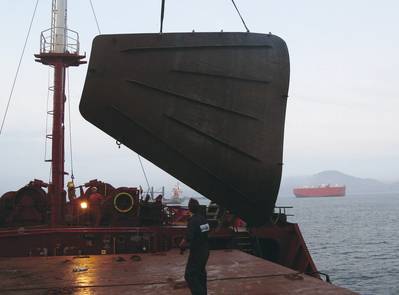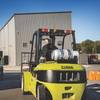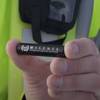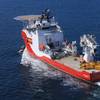Complex Steel and Cofferdam Repairs Carried Out Afloat
Hydrex has an in-house Research & Development department that can take care of the engineering aspects of an operation. In this way turnkey solutions can be offered for complex hull and other repairs that require the construction of specific equipment.
All the projects are engineered and carried out in close cooperation with the customer and any third party suppliers. R&D evaluates the feasibility of an underwater repair, continue through design and construction of customized equipment and go all the way through to successful execution of the repair or replacement and subsequent follow-up. The R&D department organizes and executes the entire job, start to finish, relieving the customer of all the hassle of coordination, planning and supervision.
Below are examples of the customized solutions by the R&D department:
Replacement of a complete, prefabricated hull section at anchor
In July 2011 the Tsavliris Salvage Group urgently dispatched a salvage tug in response to a call for assistance from bulk carrier Navios Sagittarius. The vessel had run aground on the Tonneberg Banke, about 23.5 miles east of Frederikshavn, Denmark.
The vessel was towed to Frederikshaven for a detailed underwater inspection, extensive bottom repairs, and reloading of cargo. The chief subcontracting company for the inspection, planning and repair work was Hydrex. The complex salvage operation lasted three months.
Without accurate measurements and data, the naval architects could not produce drawings and plans which would make this repair possible. So the first step for the Hydrex divers was to perform a detailed inspection of the two major areas of damage on a hull that was badly deformed, pierced, torn and indented.
Using these measurements and the original drawings of the ship, the naval architects were then able to produce final drawings from which a section and a doubler plate could be fabricated and installed. As fabrication of the section and the doubler plate was completed, preparation for installation began. In the case of the section it was necessary to cut through the hull plates where the hull was distorted and broken. Divers proceeded to cut a hole in the hull about 5 x 5 meters in size. The prefabricated insert was lowered into the water and rigged into place with chain blocks. While work was going ahead with the section, another Hydrex team worked on the fabrication and installation of the 8 x 1.8 m doubler plate in the area of DBBT No. 1. The frame was fabricated and used for measurement and then the plate itself was cut, pre-shaped and attached.
Speed was of the essence for this operation as the ship was on a long term charter and each day it was out of service was costing tens of thousands of dollars. It was the first time that an entire hull section had been prefabricated and inserted into a ship’s hull, cutting away the existing damaged plates, with the ship still afloat.
Underwater repairs in the U.A.E. allow ship to sail on after a 150-meter large grounding damage
When the shell plating of a 300-meter bulker was indented over a length of 150 meters after a grounding in the Suez Canal, a large crack 1.5 meters long appeared, making it impossible for the vessel to sail any further. To close off the crack and allow the vessel to continue its route, Hydrex sent a nine man diver/technician team to the vessel’s location, 21 miles off the coast of Fujairah, United Arabian Emirates.
The flooding had lowered the fully loaded ship from a draft of 18 meters to 22 meters. Because such a water depth means shorter diving intervals, a large diving team was immediately mobilized to the vessel to allow the team to work continuously for the 12 hours that were available each day.
To get a perfect assessment of the way the shell plating had been compressed, a special frame was made and secured over the damaged area. This allowed the diver/technician team to get exact measurements of the distorted plating. These measurements were then used to create a special cofferdam that would cover the crack and prevent it from growing further.
After the cofferdam had been positioned and secured, it was reinforced with longitudinal stiffeners and additional fortifications until it was strong enough to hold the water pressure. The tank behind the crack was then emptied, bringing the vessel back to its previous draft of 18 meters. In total the reinforcements covered an area of 18m2 and the combined length of all the welds was over 500 m.
When the operation was finished, only a few reinforcements needed to be added to the inside of the hull to prepare the ship for its journey to China.
Replacement of 40-ton azimuth thruster on crane barge in Gabon
A Hydrex diver/technician team mobilized to an offshore crane barge stationed at its service base in Gabon to replace one of the vessel’s 40-ton swing-up azimuth thrusters with the spare. The operation had to be carried out in a very short time frame because the crane barge was scheduled to leave for an operation in Nigeria. All repairs and other servicing needed to be performed before the start of this operation. For this reason going to drydock was not an option as the nearest suitable location was South Africa which would have taken the repairs far beyond the available time frame.
Hydrex had carried out a similar operation on this vessel on two occasions. Four years earlier, when the first azimuth thruster was replaced, a large mobdock (measuring 9 x 6 x 2 meters and weighing over 25 tons by itself) was constructed under Hydrex supervision in Belgium and transported to Gabon. There it was stored after the repair. It was to be used at short notice whenever future repairs were required on thrusters. This allowed for a very fast mobilization and thruster replacement on the next two occasions.
The replacement was concluded well before the start of the barge’s next operation and presented a major saving in time and money for the owner as he did not have to take the offshore unit off hire and all the way to drydock.
Comprehensive bottom plating repair on bulk carrier in Peru
When bad weather caused a 195-meter bulk carrier to roll heavily while at anchorage in Chicama, Peru, it scraped against the seabed and suffered severe damage to the forward end of its bottom plating. This resulted in an ingress of large amounts of water which caused the ship to trim by the head.
The vessel had just been loaded and the degree of trim was significant. Under those circumstances the vessel was not allowed to enter any port for unloading. We were therefore asked to find a solution to perform any possible repairs afloat. This would enable the ship to sail to its next stop and continue its schedule for the subsequent three months until the next planned drydocking.
Because the bottom plating had been damaged in two different places it was decided to carefully sail the vessel to a nearby and more suitable location in Lima at the reduced speed of 7 knots. There two doubler plates would be installed at anchorage: one on the port side to cover a crack with a length of 1500 mm, the other to close off an opening situated on the starboard side that measured up to 3500 mm at its widest point. While the smaller doubler plate, still measuring 1200 mm x 1800 mm, was installed, a local workshop started working on the second one. Due to its size the plate was delivered in three parts and was then welded together by the Hydrex team to its full size of 6 m x 6 m. Next it was reinforced with stiffeners to make sure it would be able to withstand the water pressure.
The plate was then lowered into the water with hoisting equipment. Due to the very specific shape of the affected area it was essential that the plate was precisely positioned over the designated section. Next it was welded underwater by our certified welders.
Extensive doubler plate repair in Ivory Coast allows bulker to sail after collision
A 190-meter bulker suffered severe collision damage in Lagos, Nigeria. A large hole in the hull plating prevented the ship from sailing at full speed. The classification society also demanded that the vessel go to drydock immediately unless an on-site solution was found. Hydrex therefore sent a diver/technician team to the vessel’s location to carry out an emergency doubler plate repair at anchorage. This would give the owner the opportunity to take his ship to drydock when he wanted and where he wanted.
Because of the rainy season in Nigeria, underwater visibility was almost non-existent and the current was too strong to carry out repairs at anchorage. Abidjan was the closest location suitable for this type of operation.
At this new location the team cut away part of the deformed plating. This created an even surface to position the doubler plate. Next the team made crack arrests to make sure that the cracks would not spread any further.
The bottom part of the doubler plate was then lowered from the deck and positioned over the lower half of the opening. This part of the plate was 4.5 meters wide and 2 meters high. The diver/technicians then welded the plate onto the hull. Horizontal stiffeners were installed on the plate to give it extra strength. This could not be done in advance because it would have prevented the team from adjusting the plate to the exact shape of the damaged hull.
The same procedure was repeated for the top part of the doubler plate. This part of the plate was trapezium-shaped with a base of 4.5 meters wide and a height of 2.5 meters. Both parts of the plate were then welded together to finalize the repair.
Permanent on-site collision damage repair in Greece at Neorion Syros Shipyards
In July 2014 Hydrex mobilized a team of diver/technicians to Syros, Greece, for a complex repair operation on a 118-meter, 8550 DWT chemical tanker. The vessel had suffered large cracks in her hull plating as the result of a collision.
The tanker was berthed in Egypt when another vessel struck her portside hull. This caused a large hole, severe cracks and dented plating. The collision also pushed the vessel’s starboardside hard against the fenders, denting the plating on that side as well.
She was not allowed to continue her schedule. Because it was fully laden, going into drydock was also not feasible. An on-site underwater solution was needed. Hydrex therefore proposed a permanent on-site repair using an open top cofferdam.
In consultation with Hydrex, the ship’s owner opted to take his vessel to the Neorion Syros Shipyards, situated on the island of Syros in Greece. When the ship arrived, the classification society decided that the damage to the portside hull plating was too severe to let the tanker sail any further.
The damaged area on the portside was closed off with an open top cofferdam. All water was then removed from inside the cofferdam. The yard replaced the dented shell plating. The affected web frames were also replaced. While the yard was performing the insert repair, the Hydrex diver/technicians installed temporary stiffeners on the outside of the dented starboard plating.
The repairs to both sides of the vessel were approved by the classification society. This allowed the vessel to sail from Syros. The tanker then made her way to Germany where she was unloaded before paying a quick visit to drydock for permanent repairs to the starboardside hull plating. Because no further attention was needed for the portside, the visit to drydock was very short and economical.







